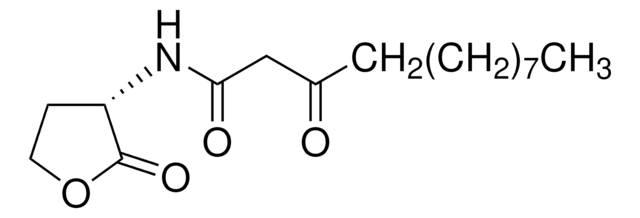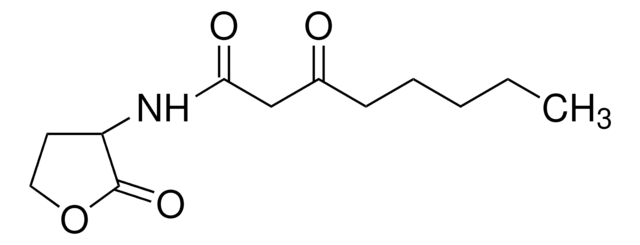804231
2-bromo-N-[(3S)-tetrahydro-2-oxo-3-furanyl]-Benzeneacetamide
Synonym(s):
AbaR, QscR inhibitor
About This Item
Recommended Products
form
solid
storage temp.
−20°C
SMILES string
O=C(OCC1)[C@@]1([H])NC(CC2=C(Br)C=CC=C2)=O
InChI
1S/C12H12BrNO3/c13-9-4-2-1-3-8(9)7-11(15)14-10-5-6-17-12(10)16/h1-4,10H,5-7H2,(H,14,15)/t10-/m0/s1
InChI key
MMJSTOMMZPSKSQ-JTQLQIEISA-N
Application
Signal Word
Warning
Hazard Statements
Precautionary Statements
Hazard Classifications
Acute Tox. 4 Oral
Storage Class Code
11 - Combustible Solids
WGK
WGK 3
Flash Point(F)
Not applicable
Flash Point(C)
Not applicable
Choose from one of the most recent versions:
Certificates of Analysis (COA)
It looks like we've run into a problem, but you can still download Certificates of Analysis from our Documents section.
If you need assistance, please contact Customer Support.
Already Own This Product?
Find documentation for the products that you have recently purchased in the Document Library.
Related Content
We study quorum sensing, how bacteria sense their density. Synthesized compounds modulate pathways, aiding research on infections in various hosts.
We study quorum sensing, how bacteria sense their density. Synthesized compounds modulate pathways, aiding research on infections in various hosts.
We study quorum sensing, how bacteria sense their density. Synthesized compounds modulate pathways, aiding research on infections in various hosts.
We study quorum sensing, how bacteria sense their density. Synthesized compounds modulate pathways, aiding research on infections in various hosts.
Our team of scientists has experience in all areas of research including Life Science, Material Science, Chemical Synthesis, Chromatography, Analytical and many others.
Contact Technical Service





![Thieno[3,2-b]thiophene 95%](/deepweb/assets/sigmaaldrich/product/structures/353/609/429fd4bf-e217-4371-80a3-9e5a4d88908b/640/429fd4bf-e217-4371-80a3-9e5a4d88908b.png)


![Thieno[2,3-b]thiophene 95%](/deepweb/assets/sigmaaldrich/product/structures/338/511/a37343cf-31cb-4a34-b903-23b3dc8e64ab/640/a37343cf-31cb-4a34-b903-23b3dc8e64ab.png)
